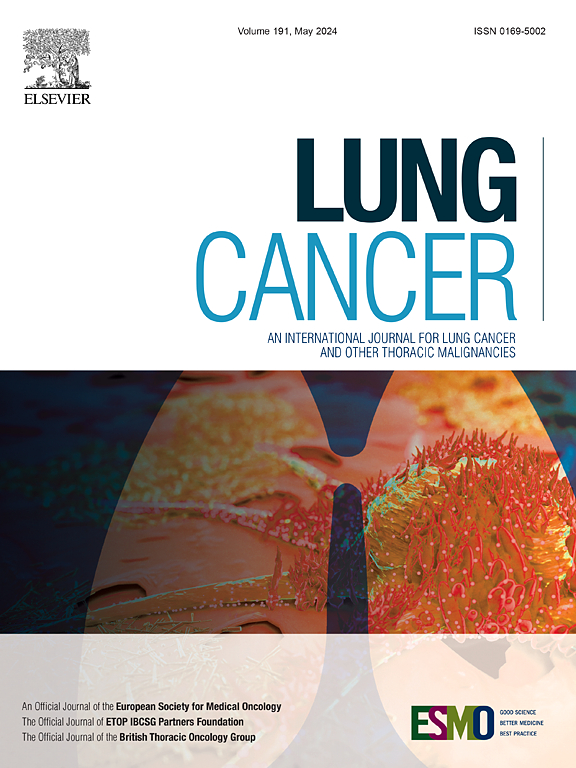肺癌临床病理特征与PET/CT摄取的关系:[18F]FAPI与[18F]FDG
IF 4.4
2区 医学
Q1 ONCOLOGY
引用次数: 0
摘要
目的探讨肺癌原发病变中[18F]成纤维细胞活化蛋白抑制剂(FAPI)和[18F]氟脱氧葡萄糖(FDG)摄取参数在正电子发射断层扫描/计算机断层扫描(PET/CT)上与肺癌患者临床病理特征的关系。方法对一项前瞻性试验进行二次分析,从2020年12月至2022年1月,在单一中心连续招募62例病理证实的肺癌患者,并在7天内(间隔至少20小时)进行匹配的[18F]FAPI和[18F]FDG PET/CT检查。结果62例肺癌患者[18F]FAPI和[18F]FDG PET/CT配对扫描结果分析显示,[18F]FAPI在不同临床分期(最大标准化摄取值[SUVmax], p = 0.017,峰值标准化摄取值[SUVpeak], p = 0.018,肿瘤与背景比[TBR], p = 0.015)和不同组织学类型(SUVmax, p = 0.039, SUVpeak, p = 0.034, TBR, p = 0.012)间的摄取差异有统计学意义,而[18F]FDG的摄取差异无统计学意义(均p >;0.05)。与程序性细胞死亡配体1 (PD-L1)肿瘤比例评分(TPS)≥1%的患者相比,TPS <;1%的FAPI-avid肿瘤体积(FTV)为[18F]FAPI (p = 0.041),代谢肿瘤体积(MTV)为[18F]FDG (p = 0.029)。比较Ki-67评分患者;50%, Ki-67评分≥50%的患者的SUVmax、SUVpeak和[18F]FDG的总病灶糖酵解(TLG)较高(p分别= 0.027、0.025和0.021)。结论我们的研究结果表明[18F]FAPI和[18F]FDG摄取与肺癌不同的临床病理特征有关,为更全面地了解肺癌的特征提供了新的见解。本文章由计算机程序翻译,如有差异,请以英文原文为准。
Relationship between clinicopathological characteristics and PET/CT uptake in lung cancer: [18F]FAPI versus [18F]FDG
Objective
This study aimed to characterize the relationships between parameters of [18F]fibroblast activation protein inhibitor (FAPI) and [18F]fluorodeoxyglucose (FDG) uptake in primary lung cancer lesions on positron emission tomography/computed tomography (PET/CT) and the clinicopathological features of lung cancer patients.
Methods
In this secondary analysis of a prospective trial, from December 2020 to January 2022, 62 patients with pathologically confirmed lung cancer were recruited continuously at a single center, and matched [18F]FAPI and [18F]FDG PET/CT examinations were performed, within 7 days but at least 20 h apart.
Results
Analysis of the paired [18F]FAPI and [18F]FDG PET/CT scanning results of 62 lung cancer patients showed significant differences in [18F]FAPI uptake among different clinical stages (maximum standardized uptake value [SUVmax], p = 0.017, peak standardized uptake value [SUVpeak], p = 0.018, tumor-to-background ratio [TBR], p = 0.015) and different histological types (SUVmax, p = 0.039, SUVpeak, p = 0.034, TBR, p = 0.012), but no corresponding differences in [18F]FDG uptake (all p > 0.05). Compared with patients with a programmed cell death ligand 1 (PD-L1) tumor proportion score (TPS) ≥ 1 %, patients with a TPS < 1 % had a higher FAPI-avid tumor volume (FTV) of [18F]FAPI (p = 0.041) and a higher metabolic tumor volume (MTV) of [18F]FDG (p = 0.029). Compared with patients with Ki-67 score < 50 %, patients with Ki-67 score ≥ 50 % had higher SUVmax, SUVpeak, and total lesion glycolysis (TLG) of [18F]FDG (p = 0.027, 0.025, and 0.021, respectively).
Conclusion
Our results indicate that [18F]FAPI and [18F]FDG uptake are related to different clinicopathological features of lung cancer, providing insights supporting a more comprehensive understanding of the characteristics of lung cancer.
求助全文
通过发布文献求助,成功后即可免费获取论文全文。
去求助
来源期刊

Lung Cancer
医学-呼吸系统
CiteScore
9.40
自引率
3.80%
发文量
407
审稿时长
25 days
期刊介绍:
Lung Cancer is an international publication covering the clinical, translational and basic science of malignancies of the lung and chest region.Original research articles, early reports, review articles, editorials and correspondence covering the prevention, epidemiology and etiology, basic biology, pathology, clinical assessment, surgery, chemotherapy, radiotherapy, combined treatment modalities, other treatment modalities and outcomes of lung cancer are welcome.
 求助内容:
求助内容: 应助结果提醒方式:
应助结果提醒方式:


